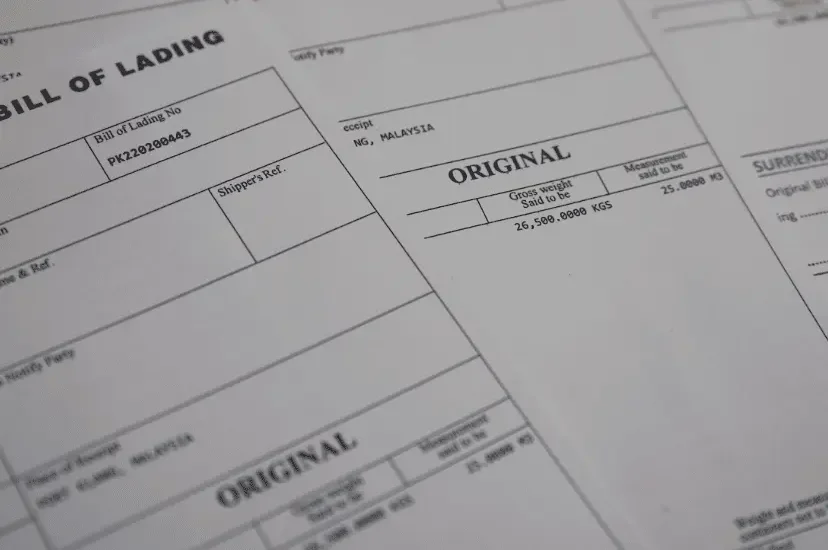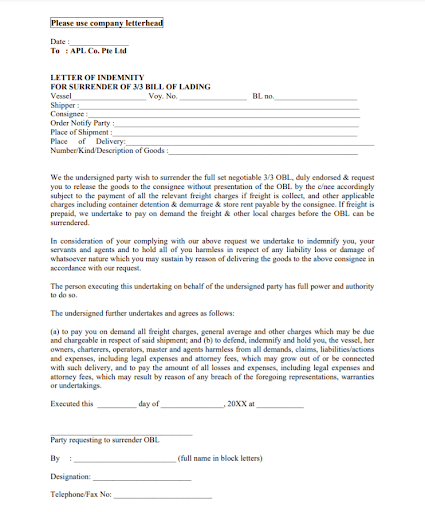- October 23, 2024
- Posted by: admin
- Categories: Export Financing, Blog

In international trade, every step in the shipping process needs to be formally completed and documented. The shipping industry is no exception, with its own set of vital documents that help manage the transfer of goods from one party to another. One such critical document is the Surrender Bill of Lading (BL).
But what exactly is a Surrender Bill of Lading, and how does it play a role in the shipping process? Let’s explore this in more detail, along with the significance of the document in international logistics.
What Is a Surrender Bill of Lading (BL)?
A Surrender Bill of Lading is a legal document that exporters issue when they are ready to give up ownership of the goods they have shipped. This document officially transfers the ownership from the exporter (the seller) to the importer (the buyer) once certain conditions, like the completion of payment, are met.
Essentially, once a Surrender BL is issued, the exporter can no longer claim ownership of the goods, and the importer now holds full rights to them. This process ensures that the transfer of ownership happens smoothly and safely, especially when the parties are based in different countries.
Why Is a Surrender Bill of Lading
Important?
The Surrender Bill of Lading is essential in international trade for several reasons. Firstly, it allows the exporter to maintain ownership of the goods while they are in transit. The exporter will only surrender the BL when they are confident that the importer has completed payment.
For importers, this document is crucial because it grants them ownership of the goods without waiting for a physical copy of the bill of lading. The Surrender BL allows for a much faster transaction, streamlining the delivery process, and minimizing the risk of delays.
How Does a Surrender Bill of Lading Work?
A Surrender BL works by acting as a form of security for both the exporter and the importer during the transaction. Here’s how the process typically unfolds:
The exporter holds the bill of lading: After shipping the goods, the exporter retains the original bill of lading. This ensures they maintain ownership and control over the goods during transit.
Payment terms are set: The terms of payment are agreed upon between the exporter and importer, often with the help of local banks that manage the documentation and payment processing.
Importer makes payment: Once the importer has made the payment for the goods, the exporter’s local bank submits the necessary documents to the importer’s bank.
Exporter surrenders ownership: After confirming the payment, the exporter surrenders the bill of lading, effectively transferring ownership to the importer.
This process is secure and convenient, especially when there is mutual trust between the exporter and importer. However, exporters need to be cautious not to surrender the BL before they receive payment to avoid losing both the goods and the payment.
The Role of a Surrender Bill of Lading in Shipping
A Surrender Bill of Lading plays a pivotal role in multiple facets of international trade and shipping. It helps facilitate smoother and more secure transactions by eliminating the need for physical documentation exchanges, making the process faster and more efficient. Let’s break down its functions across different areas:
1. Facilitating International Trade
The surrender bill of lading streamlines international trade by ensuring that ownership of goods can be transferred electronically. Exporters and importers can agree on payment terms and ownership transfer without needing to physically exchange documents. This keeps the shipping process fluid, especially for goods crossing international borders.
2. Speeding Up Cargo Release
One of the major benefits of the Surrender BL is how it accelerates the release of cargo at the destination port. Without waiting for an original bill of lading, importers can claim their goods faster. This reduces delays and helps maintain the momentum of logistics operations, particularly for time-sensitive shipments.
3. Enhancing Shipping Logistics
Incorporating a Surrender Bill of Lading into the shipping process brings an added layer of security and efficiency. The document ensures that legal ownership is clear and that there are no disputes over the goods. This minimizes the risk of legal complications and allows for faster release of goods to their rightful owners.
Information Included in a Surrender Bill of Lading
A Surrender Bill of Lading includes critical information that facilitates the transaction between exporters and importers. Some of the key details are:
- Payment terms and conditions
- Information about the parties involved (exporter, importer, and carrier)
- Descriptions of the goods being transported
This document not only acts as a legal record of the transaction but also as a crucial part of the trust-building process between the trading partners.
The Legal Format and Considerations

The format of a Surrender Bill of Lading is standardized to meet international legal requirements, ensuring its acceptance worldwide. This includes conditions for telex release and express BL, both of which play key roles in the official transfer of legal ownership.
The standardization of this document is vital for preventing disputes, as it provides clarity and transparency to all parties involved. Whether it’s the exporter, importer, carrier, or bank, everyone can be assured that the terms of the deal are clear and legally binding.
Practical Uses of a Surrender Bill of Lading
The practical applications of a Surrender Bill of Lading make it an essential tool for modern shipping. It’s particularly useful in situations where speed and efficiency are important.
1. Ideal for Fast-Paced Transactions
The Surrender BL is commonly used in high-speed international trade, where both parties need the goods to be transferred quickly. When exporters use a telex release system, the importer can receive the goods almost immediately, helping to keep the shipping process efficient.
2. Guidelines for Shippers and Carriers
For shippers and carriers, following the proper procedures for surrendering a bill of lading is crucial. The document must be accurately filled out and submitted to the carrier or bank as soon as possible to avoid delays. This is particularly important for telex release or express BL, which allows for faster cargo release.
Risks Involved with Surrender Bill of Lading
Although a Surrender Bill of Lading offers numerous benefits, it also comes with risks that need to be carefully managed. For example:
Risk of Non-Payment: If the exporter surrenders the BL before the importer has completed the payment, the importer may claim ownership of the goods without paying for them. This is why exporters should always ensure that payment has been confirmed before surrendering the BL.
Carrier Refusals: In some cases, carriers may refuse to release the goods without the original Bill of Lading. This can lead to complications, especially if the goods are lost, misplaced, or damaged.
Legal Issues: If not handled correctly, surrendering a bill of lading prematurely can expose the exporter to legal challenges. It is essential to follow proper procedures and make sure all documentation is in order.
Conclusion
In the world of global shipping, the Surrender Bill of Lading plays a crucial role in facilitating trade, transferring legal ownership, and ensuring the smooth movement of goods across borders. By speeding up the cargo release process and minimizing legal complications, this document is an invaluable tool for exporters and importers alike.
Understanding how a Surrender BL works, its legal implications, and the risks involved can help you navigate the complexities of international trade more confidently. When used correctly, it can streamline shipping operations, build trust between trading partners, and safeguard the interests of both exporters and importers.
Also Read: Exploring the Diverse Types of Bill of Lading in Shipping